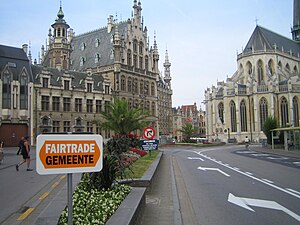Fairtrade Town
This article needs additional citations for verification. (May 2010) |

The Fair Trade Towns campaign is the result of a grass-roots citizens movement that started in the UK in 2001 (see below). It allows citizens to get together in order to self-proclaim their town (or other local geographical area) as a region that complies with a few general Fair Trade criteria, that can be adapted from country to country but which retain their main elements.
In some countries, the Fair Trade Town became a status awarded by a recognized Fair Trade certification body (i.e. the
History
The Fair Trade Town campaign was first launched in 2001 in
As the activities at Garstang gained wider attention, the
In an attempt to replicate the success of the
In November 2006, the first ever European Fair Trade Towns conference was hosted at London Southbank University. The goals of the conference were to
- identify and develop procedures to strengthen the links within and between local communities and private and public organisations;
- develop strategies to enable the UK Fair Trade Towns model to meet the requirements of each individual country.
Following the success of the first event, a second Fair Trade towns conference was subsequently held in Brussels in January 2008. The sixth conference was held in Poznan (Poland) in November 2012, and the 2013 and 2014 international conferences are foreseen to take place in Oslo (Norway) and Kumamoto (Japan), respectively.
There are currently Fair Trade Towns in Australia, Austria, Belgium, Brazil, Canada, Denmark, Finland, France, Ireland, Italy, Norway, New Zealand, Spain, Sweden, the Netherlands, Germany, the United Kingdom and the United States. The list of Fairtrade settlements is a more comprehensive current list.
Criteria

Formal guidelines have been produced jointly by several
- Local council passes a canteens.
- A range of (at least two) Fair Trade products is readily available in the area's cafés/cateringestablishments.
- Target for number of retail outlets: population of < 10000 - 1 retail outlet per 2500; population < 200000 - 1 retail outlet per 5000; population of < 500000 - 1 retail outlet per 10000.
- Target for number of catering outlets: population of < 10000 - 1 catering outlet per 5000; population < 200000 - 1 catering outlet per 10000; population of < 500000 - 1 catering outlet per 20000
- Fair Trade products are used by a number of local work places (estate agents, hairdressers, etc.) and community organisations (churches, schools, etc.)
- Attract media coverage and popular support for the campaign.
- A local Fair Trade steering group is convened to ensure continued commitment to its Fair Trade Town status.
Other initiatives
In 2002 The
The draft criteria for a "Fair Trade Nation" are:[1] Archived 2013-02-02 at the Wayback Machine
- 75% of the population should purchase a Fair Trade product every year.
- 40% of people regularly buy Fair Trade products.
- All local authorities have active Fair Trade groups working towards Fair Trade status.
- 55% local authority areas with Fair Trade status with 10% annual increase in following years
Wales became the world's first Fair Trade nation in June 2008.
See also
- Transition Towns
- List of Fair Trade settlements
References
- ^ Garstang Fair Trade Town (2002). Garstang Fair Trade Town. URL accessed on December 14, 2006.
